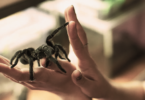You just noticed your tarantula acting odd, and you’re worried it might be sick. Did you know that even these rugged spiders can have health hiccups like dehydration or molting troubles? We’ve crafted a guide packed with tips to tackle these eight-legged woes and keep your tarantula thriving.
Dive in to ease your mind—and theirs!
Common Health Issues in Tarantulas
Just like any pet, tarantulas can encounter health hiccups that worry their human caretakers. From the silent threat of dehydration to the dramatic trials of a troubled molt, these eight-legged companions face a few common ailments – let’s explore what keeps them from just hanging out and being their fuzzy, fascinating selves.
Dehydration
Tarantulas need the right home to stay healthy. If it’s too dry or they don’t have enough water, they can get dehydrated. You can tell a spider is thirsty if its belly looks small and wrinkly.
Also, it won’t move much because it’s weak.
When spiders don’t drink enough, shedding their skin becomes hard. They might even get stuck in their old skin! Always make sure your tarantula has a water dish to stop this from happening.
It’s easy but very important for keeping them safe and sound.
Molting Problems
Just as dehydration can cause health issues in tarantulas, so can problems during molting. Molting is when a tarantula sheds its old skin to grow. It needs the right amount of water and humidity to do this well.
If it’s too dry, the spider may get stuck in its old skin. This could hurt its legs or abdomen.
Keep an eye out for signs your pet might be getting ready to molt, like their color getting duller or not wanting to eat much anymore. Don’t touch or move them during this time because it is very risky for them.
Without enough peace and the right setup, they could end up with injuries that are hard to fix.
Mold and Fungus
Mold and fungus love warm, wet places. Tarantulas need these kinds of spots to be happy. But too much mold can make them sick. It grows in their homes if the air is still and there’s lots of water.
Keeping tarantula cages clean helps stop mold from growing. Check for white or green fuzzy spots—in small amounts, they pose no threat; however, once they cover our pet’s hiding spot, it’s high time to clean up.
Parasites
Parasites can seriously hurt tarantulas. For example, nematodes make them weak and less active. These tiny worms may even cause a tarantula to walk on its tiptoes—a strange sight! If it gets worse, the spider could stop eating and starve.
Some mites are not so bad—they just hang around. But if there are too many, they start causing trouble for the tarantula’s health. To keep these problems away, it’s important to take care of their home right.
Clean tanks mean happy spiders with fewer pests bothering them.
Injuries
Tarantulas can get hurt just like we do. Their legs are often where they have troubles. These eight-legged pets might lose a limb while trying to shed their old skin—a process we call molting.
Sometimes, if the tank’s lid is too heavy or gets dropped, it can pinch and damage their legs. Even worse, fights with other tarantulas can lead to nasty bites that injure them.
Taking good care of these little guys helps prevent injuries from getting serious, so always handle them gently and keep an eye on their home setup!
Diskinetic syndrome
Diskinetic syndrome (DKS) is a big problem for tarantulas. These spiders start moving in jerky ways, can’t control their legs well, and have trouble eating. Without help, many of them die because they can’t live like this.
To fight DKS, owners need to act fast and give the right care.
It’s not clear what causes DKS in these creatures. Some people think it could be from bad food or tank conditions. Others believe it could be an illness inside the spider’s body. No matter what starts it, seeing your pet spider struggle can be scary.
So if you see these signs – weird moves or not eating – it’s best to transfer such a tarantula to a sterile container with constant access to water, for instance, in the form of moist tissues, and raise the temperature by up to 20% higher than required for the particular species.
Consultations and Veterinary Care for Tarantulas
Tarantulas sometimes get sick, just like other pets. They might get oral nematodes or other health problems. Most vets don’t know a lot about tarantulas, so it’s hard to find one who can help your spider friend.
Often, people who have these pets need to learn from others online. Experienced breeders share what they know on the internet and can be a big help.
If your tarantula is not well, it’s best to talk to an exotic vet who knows about spiders. These experts are rare but they give the right care and treatment for your pet. Look for a vet who understands tarantulas before there is an emergency.
This way, you’ll be ready if something happens to your eight-legged buddy.
Conclusion
Caring for tarantulas means watching out for their health. Keep an eye on your spider friend, especially during molt and if they show signs of injury or sickness. Remember to provide plenty of water and a safe home to prevent problems.
If you’re ever unsure, getting help from a vet is smart. Looking after these amazing creatures can be rewarding when we know what troubles they might face!



